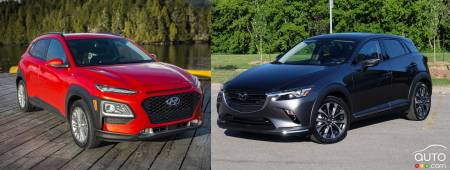To give you an idea just how important the CX-3 was to Mazda when the little crossover launched in 2016, the Japanese automaker took the Mazda2 off the market (this after it had been presented to the press) to avoid running any interference on the CX-3. The Mazda2 was passed off to Toyota under the name Yaris sedan.
Evidently Mazda made the right call: sales in 2018 grew to more than 12,440 units, up 15% over 2017. Mazda can safely say about its CX-3 operation, Mission Accomplished.
As for the Hyundai Kona, the Korean manufacturer behind it can claim an even more impressive victory. On its first full year on the market in 2018, the Kona attracted 14,497 buyers. That was enough to place it in second place in the category, behind the Nissan Qashqai (at 19,662 units) and… ahead of the Mazda CX-3.
The biggest loser of the 2018 year was the Honda HR-V, which saw its sales drop from over 14,000 units in 2017 to 9,047 in 2018. So if you wondering who the Kona snatched market share from, there’s your answer.

Mazda CX-3
The current CX-3 arrives at its mid-cycle point in 2019 and that’s usually the signal to put a little layer of fresh makeup on the model to keep it pretty and attractive for a few more years.
Mazda has dutifully equipped its CX-3 with a new grille, taillights and rims, while the interior features more-premium materials, new seats and a centre console designed around a new power parking brake switch that replaces the traditional handbrake (pity).
Based on the platform of the Mazda2, the CX-3 simply offers a different look, but it’s a winning one. Small, wide and compact, the small SUV offers beautiful proportions.
Getting your money’s worth
In the tiny-ute segment, the overriding goal is to offer the best value for money. The entry-level GX trim of the CX-3 comes standard with front-wheel drive and a 6-speed manual gearbox, a combination limited to this version. A 6-speed automatic is optional, as is the addition of all-wheel drive.
The GS mid-range starts with a 6-speed automatic transmission and can also be configured in 4WD mode. The GT version comes automatically with all-wheel drive and the automatic transmission.
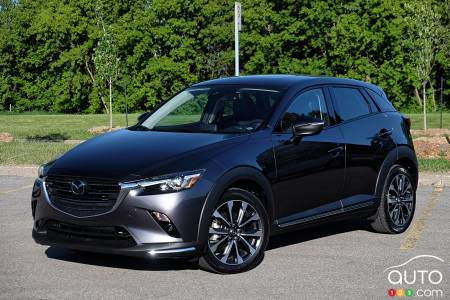
One of the few changes in 2019 is the addition of Blind Spot Monitoring to the GX. All models come with the expected basics like climate control and power windows, as well as push-button start, that blind spot monitoring and a rear traffic alert.
The GS adds alloy wheels, heated exterior mirrors, automatic headlamps and windshield wipers, heated steering wheel, automatic climate control, heated front seats, leather-wrapped gear shifter and steering wheel, and a new height adjustment for the front passenger seat.
On the options list you’ll find the i-Activesense active safety suite including cruise control, intelligent braking assistance, advanced pedestrian detection and obstacle warning, automatic high beams and adaptive and auto-leveling LED headlights.
The GT model adds recognition for road signs, LED fog lights, navigation, passive keyless entry system, 10-way power driver seat, leather trim and suede door trim.
Same engine
Under the hood there’s no change, with power still coming from the same 2.0L 4-cylinder engine. Mazda says it’s reworked the engine to enhance refinement and efficiency, adding two horses for a total of 148, while torque remains at 146 lb-ft.
New it isn’t, but this engine does a very good job and the finest quality of the CX-3 remains the driving pleasure it gifts its owner. It has the dynamic personality so typical of Mazda products. You can expect to get around 7.5L/100 km in mixed driving environments. There’s a Sport mode that extends the gears to get the most out of the power of the engine.
Overall, don’t set your expectations too high when it comes to performance capabilities. That said, it’s also true that the CX-3 is still more fun to drive than the most of the small utilities in its class.
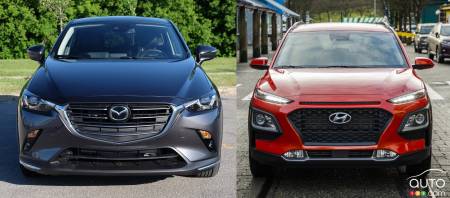
Hyundai Kona
Like other crossover models from the manufacturer, namely the Tucson and Santa Fe, Hyundai says it named the Kona after an American city considered a tourist destination; in the case of Kona, the name’s borrowed from a coastal region of the Big Island of Hawaii (Tucson of course is in Arizona, and Santa Fe in New Mexico).
The flip side of Hyundai arriving late to the parade in this segment is that it took the time to analyze the market and develop a product that answers the needs and wants of consumers. For proof of the company’s wisdom, you need look no further than the sales its new crossover has racked up.
More choices
For the front end of the Kona, Hyundai seems to have been inspired by Jeep for the design, because the face of this small utility model looks like the Cherokee with its unique lighting. The rest of the vehicle is more in tune with the current Hyundai family.
In terms of space and format, Kona offers more than the CX-3. A small family can fit comfortably into the Kona, and you can’t say the same for the CX-3.
Kona also offers more choices at all levels. For one thing, there are five versions: Essential, Preferred, Luxury, Trend and Ultimate. The first two can be had with front-wheel drive or all-wheel drive, while the rest are all-wheel drive vehicles only.
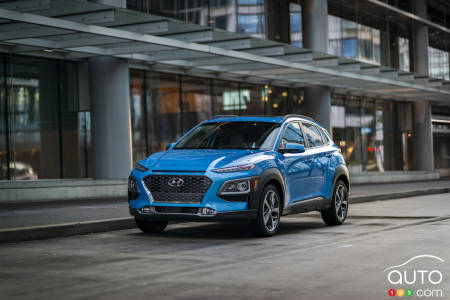
More bang for the buck
With the Essential version, you get 16-inch wheels (like with Mazda’s crossover), LED daytime running lights, automatic headlights, heated side mirrors, intermittent front wipers, heated front seats, fabric upholstery, manually adjustable driver's seat, Android Auto and Apple CarPlay compatibility, 6-speaker audio system, climate control, cruise control, power windows and door locks and keyless entry. Definitely, buyers get a more comprehensive selection of included equipment than the base-model CX-3.
The Preferred version switches to 17-inch wheels and gets fog lights, blind spot collision alert, lane departure warning with rear traffic alert, leather-wrapped steering wheel and shift knob, heated steering wheel and keyless passive access.
The Luxury version brings an 8-position power driver’s seat with lumbar support, rear parking distance alarm, automatic climate control and sunroof. This trim also includes the Hyundai SmartSense Basic Safety Suite, which includes lane keeping assist, driver attention warning and front pass avoidance assist with pedestrian detection.
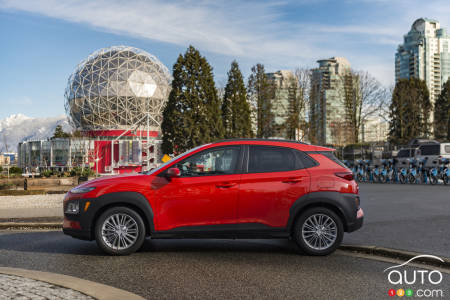
Next up, the Trend version. This gets you 18-inch wheels, LED taillights, chrome-ringed grille, dark-grey body liner, silver rear skid plate, rain-sensitive wipers and head-up display. The trim also comes with fabric upholstery for the seats and removes SmartSense features.
Leather-covered, power-adjustable seats and SmartSense are back in the Ultimate trim, which also featuring LED headlamps with active cornering lights, 8.0-inch touchscreen, wireless charger, gauge display digital color and auto-dimming rearview mirror.
Two engine choices
Under the hood, the Kona is one of the only vehicles in the segment to offer two engines. The base one is a 4-cylinder, 2.0L unit making 147 hp and 132 lb-ft of torque, paired with a 6-speed automatic transmission. As an option you can go for a 1.6L turbo engine delivering 175 hp and 195 lb-ft of torque connected to a 7-speed dual-clutch transmission. You also have the choice of two- or four-wheel drive versions and Eco, Normal and Sport drive modes.
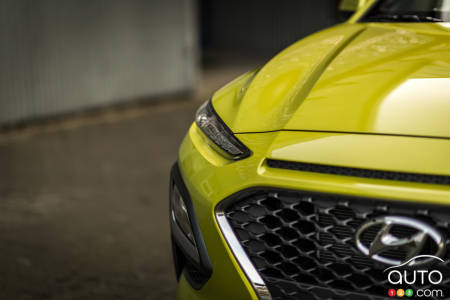
At the wheel of the 2.0L version, power is barely enough if you have several passengers on board and when you floor the gas, the engine has to work pretty hard and the soundproofing is not enough to camouflage the tortured complaints from the powertrain.
Fortunately, the chassis (which came from the Tucson model and was adapted for the Kona) is solid and road grip is competent and confidence-inspiring.
It’s in its 1.6L version that the Kona really starts to shine. The 175 horses accompanied by generous torque frankly transform the driving experience. The handling, the overall balance, dynamics, everything is enhanced by one notch if not two. The Sport mode really gives a boost and there’s clearly a much better synchronicity between road and driver.
Mazda3 advantages
From a purely aesthetic point of view, the CX-3 is better proportioned and more successful in its design than the Kona, plus it’s a more interesting model to drive. It offers a pleasant interior space (especially in front), good finishing, a nice level of comfort and, if you’re comparing 2.0L-to-2.0L versions, a superior driving experience.
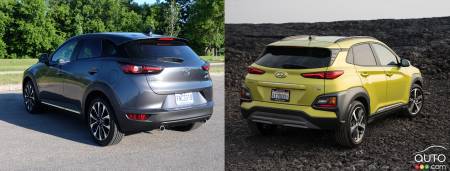
Kona advantages
The Kona offers a more generously proportioned interior space that can realistically accommodate a small family. Like all Hyundai products, this model also offers a ton of equipment for the price. Then there’s the added benefit of being able to choose between two engine choices, one of which is nicely sporty and should attract an even larger swath of the market in this segment.
Similarities
There’s no wrong choice to be made between these two vehicles. Neither have had any reliability issues so far and both come with good warranties. But really, they don’t target quite the same clientele. The pint-sized dimensions of the Mazda CX-3 constitute its biggest handicap. You have to think that the recent presentation at the Geneva Motor Show of the new CX-30 (and its format that fits in between the smaller CX-3 and the bigger CX-5) is an acknowledgement of the CX-3’s weakness in this respect.
Our verdict
Are you single, or a couple without kids? The CX-3 offers elegance and driving satisfaction at a reasonable price. For the others, there’s the Kona, complete with legitimate room for four and a list of equipment that’s really generous for the price. There’s a reason why this newcomer climbed with a bullet to the top of the sales charts. People recognize a good deal when they see one (just make sure you get the 1.6L turbo!)
2019 Mazda CX-3
We liked
Nimble steering
Small nervous engine
Good road grip
We liked less
No Apple CarPlay or Auto Android integration
Restricted passenger space at the rear
2019 Hyundai Kona
We liked
Unique styling
Game-changing 1.6L engine
Solid chassis
We liked less
2.0L engine is a bit underpowered
Rear seats are too firm
Limited cargo space
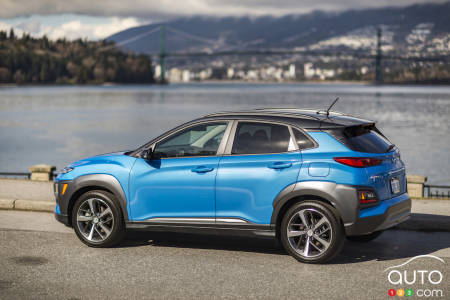
Specifications
| ... | 2019 Mazda CX-3 | 2019 Hyundai Kona | |
| Transmission | 6-spd man or auto | 6-spd auto or DSG 7 | |
| Drivetrain | FWD or 4WD | FWD or AWD | |
| 4WD auto | 4WD auto (2.0L) | ||
| Fuel consumption (city) | 8.6L/100 km | 9.2L/100 km | |
| Fuel consumption (highway) | 7.4L/100 km | 7.8L/100 km | |
| 4WD auto (1.6L T) | |||
| Fuel consumption (city) | 9.0L/100 km | ||
| Fuel consumption (highway) | 8.0L/100 km | ||
| Fuel capacity | 2WD: 48 litres | 50 litres | |
| 4WD: 45 litres | |||
| Engine | |||
| Type | Gas | Gas | |
| 2.0L engine | 2.0L engine | ||
| Output | 148 hp | 147 hp | |
| Torque | 146 lb-ft | 132 lb-ft | |
| Cylinders | 4 cylinders | ||
| Displacement | 2.0 litres | 2.0 litres | |
| 1.6L turbo engine | |||
| Output | 175 hp | ||
| Torque | 195 lb-ft | ||
| Cylinders | 4 cylinders | ||
| Displacement | 1.6 litres turbo | ||
| Capacity | |||
| Trunk space | 452 L, 1,528 L (folded) | 544 L, 1,296 L (folded) | |
| Towing capacity | 454 kg | 600 kg | |
| Dimensions | |||
| Length | 4,274 mm | 4,165 mm | |
| Width | 1,767 mm | 1,800 mm | |
| Height | 1,542 mm | 1,550 mm | |
| Wheelbase | 2,570 mm | 2,600 mm | |
| Warranty | 3 years/unlimited | 5 years/100,000 km | |
| Prices | $21,045 to $31,045 | $21,099 to $31,099 |


